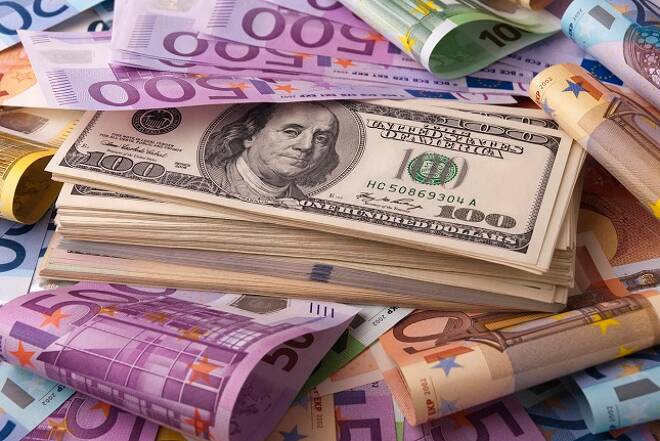Advertisement
Advertisement
German GDP and U.S Retail Sales Figures Put the EUR and USD in the Spotlight
By:
Brexit and Trade talks are on the political agenda, while Germany's GDP numbers and retail sales figures out of the U.S will be in focus on the data front.
Earlier in the Day:
Economic data released through the Asian session this morning included 1st estimate GDP numbers out of Japan, house price figures out of the UK and trade data out of China.
For the Japanese Yen,
According to figures released by the Cabinet Office, the economy grew by 1.4% in the 4th quarter, year-on-year, which was in line with forecasts. Quarter-on-quarter, the economy grew by 0.3%, which was softer than a forecasted 0.4% growth rate. 3rd quarter GDP figures were revised. Year-on-year, the economy contracted by 2.6% in the 3rd quarter, year-on-year, with the economy contracting by 0.7%, quarter-on-quarter.
Growth in the 4th quarter was attributed to strong business investments and domestic consumption, as the economy recovered from the floods and earthquakes that plagued the 3rd quarter.
A drag on the economy was weaker exports, with the U.S – China trade war impacting demand from China.
Upon release of the figures, the Japanese Yen moved from ¥110.945 to ¥110.980, against the Dollar. At the time of writing, the Yen stood at ¥111.05, down 0.04% for the session.
Out of China,
The trade surplus narrowed from $57.06bn to $39.16bn, in U.S Dollar terms in January, which was better than a forecasted narrowing to $33.50bn.
- Exports surged by 9.1%, reversing December’s 4.4% slide and coming in well ahead of a forecasted 3.3% fall.
- Imports fell by 1.5%, which was also better than a forecasted 9% slide. In December, imports had fallen by 7.6%.
While better than expected numbers are welcome, a narrowing in China’s surplus with the U.S to $27.3bn, will good news as talks resume. One concern may be a 41.2% slide in imports from the U.S, however.
The Aussie Dollar moved from $0.70972 to $0.71096 upon release of the figures. At the time of writing, the Aussie Dollar stood at $0.7116, up by 0.37% for the session.
Elsewhere,
The Kiwi Dollar stood at $0.6828, up by 0.46% for the session. Following a more hawkish than expected RBNZ, support came from hopes of a delay to the rollout of tariffs on Chinese goods imported into the U.S and better than forecasted trade data out of China.
The Day Ahead:
For the EUR
Economic data scheduled for release include prelim 4th quarter GDP numbers out of Germany and 2nd estimate GDP numbers out of the Eurozone.
The focus will be on Germany’s GDP numbers that are forecasted to reflect a return to growth in the quarter, while annual growth is forecasted to slow to 0.9%.
Economic indicators out of the Eurozone’s economic powerhouse have raised a number of red flags, leaving the EUR particularly sensitive to today’s figures.
At the time of writing, the EUR up by 0.12% at $1.1274.
For the Pound
There are no material stats scheduled for release through the day, following January’s RICS House Price Balance figures released in the early hours.
According to figures released by the Royal Institute of Chartered Surveyors, the House Price Balance fell from -19% to -22%, in January. The balance was worse than a forecasted -20%.
While there are no stats in focus through the day, we can expect Brexit chatter to continue to provide direction. Deal or Delay is the big debate for now.
At the time of writing, the Pound was up 0.16% at $1.2866.
Across the Pond
Economic data scheduled for release includes January wholesale inflation figures and, of greater significance, January’s retail sales figures. November’s business inventories and the weekly jobless claims are also due out but are unlikely to have a material impact barring any particularly dire numbers.
Outside of the numbers, the focus will be on trade talks with China and whether the U.S administration agrees to a delay to the 1st March deadline.
At the time of writing, the Dollar Spot Index was down by 0.07% to 97.065.
For the Loonie
Economic data scheduled for release includes December manufacturing sales and new house price index figures. We would expect the focus to be on the manufacturing sales figures that are forecasted to be Loonie positive.
Outside of the numbers, market risk appetite and sentiment towards trade talks between the U.S and China will also provide direction through the day.
The Loonie was up by 0.07% to C$1.3245, against the U.S Dollar, at the time of writing.
About the Author
Bob Masonauthor
With over 28 years of experience in the financial industry, Bob has worked with various global rating agencies and multinational banks. Currently he is covering currencies, commodities, alternative asset classes and global equities, focusing mostly on European and Asian markets.
Advertisement
